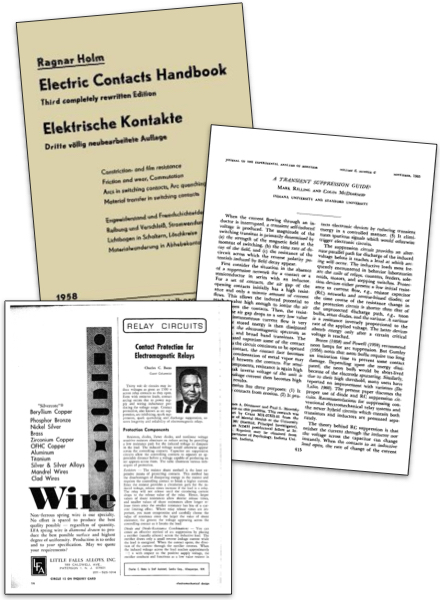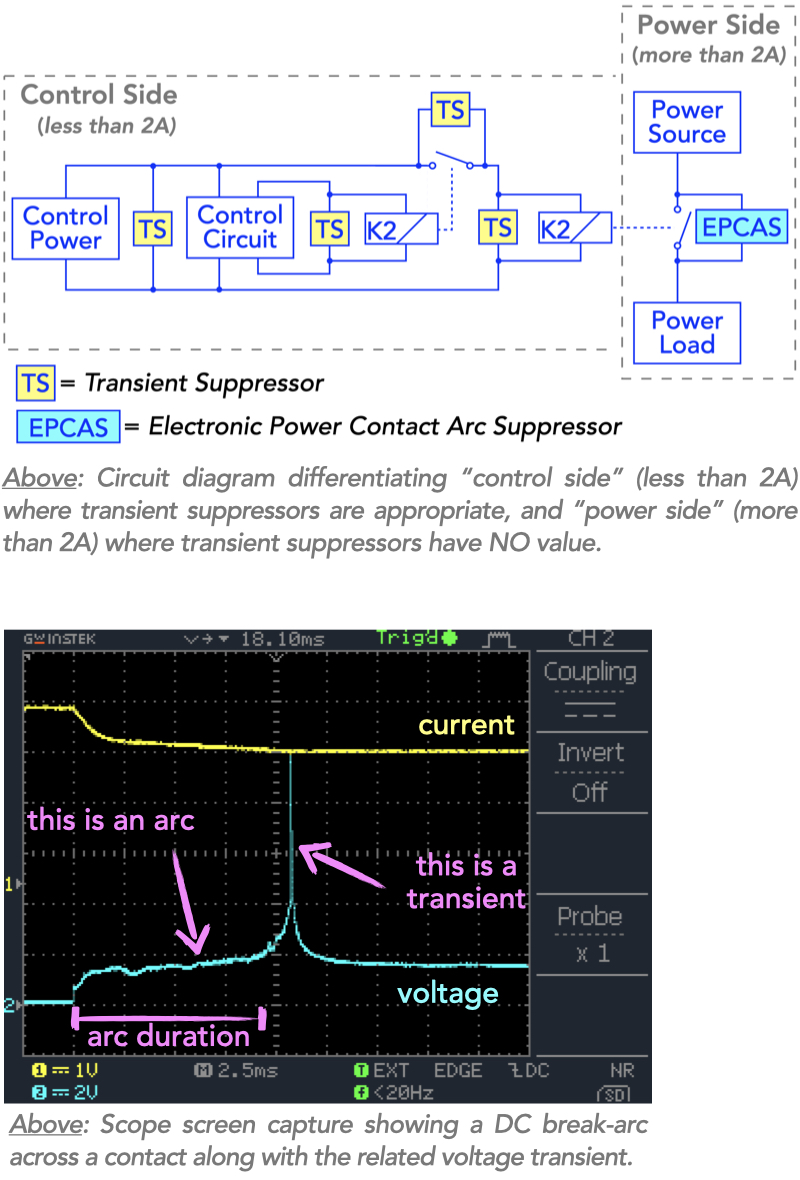What Is Arc Suppression?
Does “Transient Suppression” = “Contact Protection” = “Arc Suppression”?
Answers From an Engineering Handbook, a Scientific Paper, and a Magazine Article vs. Our Discoveries, Findings, and Conclusions
Three publications represent approaches to arc suppression that began in the 1950s and 1960s and have continued influence today. We will compare these approaches with findings derived from our own industrial research regarding arc suppression as contact protection.
Arc Suppression, 1958 — Ragnar Holm, the scientist who “wrote the book” on contacts, documented his investigation of arc suppression (or minimization) methods. Holm’s “Electric Contacts Handbook” termed his efforts using RC combinations as “arc quenching” and established that there are differences between MAKE arcs and BREAK arcs. He also experimentally proved that the quench capacitor sizes become large as currents increase.
Transient Suppression, 1965 — Researchers Rilling and McDiarmid, published a paper titled “A Transient Suppression Guide” and stated: “Arc Suppression has three purposes: (1) It protects relay contacts from erosion. (2) It protects electronic devices by reducing transient energy in a controlled manner. (3) It eliminates spurious signals which would otherwise trigger electronic circuits. The paper then introduces two equations: C=I²÷10 and R=E÷(10xIx(1+(50÷E))) for calculating “properly sized” R and C component values. Rilling and McDiarmid offered neither experimental validation, nor a scope of limitations, nor cite a source for the equations. The paper also implies “transient suppression” is equivalent to “arc suppression”.
Contact Protection, 1966 — Charles C. Bates, a “guest columnist” and “Staff Assistant, Sandia Corp., Albuquerque, N.M.” wrote an article for the Aug. 1966 issue of “Electromechanical Design” magazine titled “Contact Protection for Electromagnetic Relays” in which he states that “contact protection is also known as arc suppression”. His article includes Rilling and McDiarmid equations, albeit defing the RC components for “arc suppressor” applications. In addition, he explicitly states that “contact protection” equals “arc suppression” while implicitly equating both with “transient suppression”.

Transient suppression has NO VALUE switching currents of 2A or more. Unfortunately, C.C. Bate’s article and its RC equations were enthusiastically received by the electromechanical industry … and the desire to address the problem of contact arcing overcame the incorrect assumptions and omissions in Bates’s article. In fact, to this day the Bates magazine article (often referred to as a “scientific paper”) is frequently cited in data sheets and other industry publications, often with Bates being credited as the creator of the RC equations.
We believe the “C.C. Bates equations” have been so uncritically accepted because power contact arcing is not well understood. For instance, a transient suppressor doesn’t differentiate between arcs initiated during contact make and arcs initiated during break. As current increases, the ever larger capacitor required by the “C.C. Bates equations” would absorb energy from the break-arc, which in turn fuel damaging make-bounce-arcs (acting like an arc welder). Another example is the common belief that the voltage spike that occurs after the arc plasma has finished burning cause arcing.
In summary, transient suppressors are NOT arc suppressors, and therefore DO NOT protect contacts. And, while many components are called “arc suppressors”, only an Electronic Power Contact Arc Suppressor (EPCAS) truly suppresses arcing and protects contacts. In other words:
EPCAS = ARC SUPPRESSION = CONTACT PROTECTION
TRANSIENT SUPPRESSION ≠ ARC SUPPRESSION
TRANSIENT SUPPRESSION ≠ CONTACT PROTECTION

